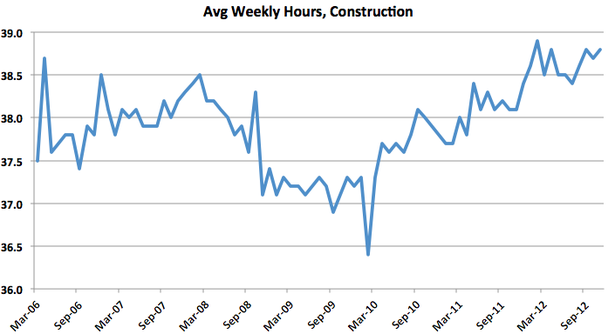The Mystery of Housing's Jobless Recovery
If this is a housing recovery, where are the housing jobs?
That's the big question after yesterday's jobs report showed the economy still stuck in something just above stall speed. You could change the year on this jobs report from 2012 to 2011 or 2010 and you probably wouldn't be able to tell the difference. Things are getting better, but not getting better fast enough -- unless you think getting back to full employment in 2020 is fast enough. Only a real housing recovery can save us from that depressing math.
There have been -- wait for it! -- green shoots in housing the past six months. Prices rose 3 percent year-over-year in September, home-builder confidence is up and so are housing permits. All of these indicators have hit post-2006 highs, albeit from a very low, semi-dormant base. But construction employment has barely budged. Superstorm Sandy certainly skewed the November numbers, but construction's 20,000 loss this past month wasn't a complete aberration -- there hasn't been any uptick in construction despite the uptick in housing. The chart below compares building permits with construction jobs since March 2006, and gives us a sense of this disconnect. (Yes, that modest wiggle up in permits the past year is what passes for a housing recovery nowadays).
As Evan Soltas points out, construction employment hasn't increased because construction hours have increased. The chart below shows that the average construction workweek is now a bit longer than it was at the height of the boom.
The good news here is builders are reaching the point where they can't do much more with less. They're going to need to hire more construction workers soon -- as long as housing demand doesn't go back into hibernation. It shouldn't. Households have paid down, or defaulted on, quite a bit of debt since 2007, and that is continuing -- which should translate into more spending and more household formation, barring massive austerity that makes it harder for households to save. The Fed is doing its part by buying $40 billion of mortgage bonds a month to push borrowing costs even lower. And if Obama really does recess appoint a new Federal Housing Finance Agency chief like he promised, the door could open to even more refinancings, and maybe even writedowns.
The housing recovery is real, and it's set to accelerate in 2013 -- finally taking construction employment with it. As long as Washington doesn't screw it up. But don't worry. Alan Simpson is dancing to Gangnam Style to rally support to his debt plan. So this fiscal cliff thing is pretty much solved.
Matthew O'Brien is a former senior associate editor at The Atlantic.

